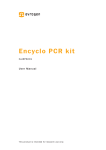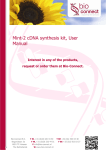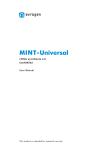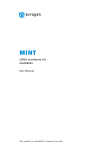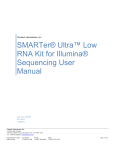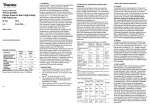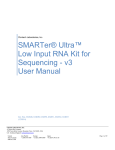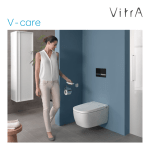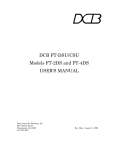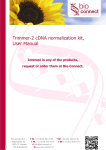Download User Manual
Transcript
Innovative Biotechnology Company Evrogen JCS MiklukhoMaklaya str,16/10 117997, Moscow, Russia Tel: +7(495) 429 8020 Fax: +7(495) 429 8520 www.evrogen.com Encyclo PCR kit Cat#PK001 User Manual This product is intended for research use only. TABLE OF CONTENTS I. Kit components and storage conditions II. Product description III. Guidelines for PCR amplification A. General Considerations B. PCR protocol C. Notes about Reaction Components D. Cycling conditions E. Control PCR IV. Troubleshooting Guide V. References VI. Appendix A. Recommendations for Electrophoresis B. Dealing with contamination Encyclo PCR kit 1 2 3 6 7 8 10 13 13 14 www.evrogen.ru 1 I. Kit components and storage conditions Component Amount 50X Encyclo polymerase mix 100 µl 10X Encyclo buffer 600 µl 50X dNTP mix (10mM each) 120 µl Control DNA template 10 µl Control PCR primer mix (10 µM each primer) 10 µl Sterile PCR water 1.5 ml Encyclo PCR kit provides reagents for 100 standard PCR reactions (50 µl each). The kit includes 1.5 ml of PCRgrade H2O, which is enough for approximately 40 standard PCRs. We recommend to use Milliporefiltered H2O for the rest of reactions. Do not use autoclaved H2O for PCR. Shipping/Storage Encyclo Polymerase mix is shipped on dry ice or at 20 OC. All other components of Encyclo PCR kit can be shipped at ambient temperature. Once arrived, the kit must be kept at 20 OC. II. Product description Encyclo PCR kit is intended for most PCR and primer extension applications. It is especially recommended for cDNA amplification due to optimal combination of high fidelity and processivity provided by Encyclo polymerase mix. Evrogen Encyclo polymerase mix produces high yields of PCR products from a wide variety of templates and is suitable for difficult templates, long PCR (up to 15 kb), and cloning. Encyclo polymerase mix features 1. High processive 5'>3' DNA polymerase activity 2. Proofreading 3'>5' exonuclease activity 3. Automatic hot start 4. TAcloning compatibility technical support: [email protected] 2 Encyclo buffer has been developed to provide successful amplification of long DNA templates and is necessary for optimal perfrormance of the Encyclo polymerasy mix. The kit also includes a mix of highpurity deoxyribonucleotides, sterile PCR water, control DNA template and primer mix for positive control PCR. Product Use Limitations Encyclo PCR kit is intended for research purposes only. III. Guidelines for PCR amplification A. General Considerations 1. Avoid crosscontamination Minute amounts of contaminating DNA can lead to nonspecific amplification even in the absence of an added DNA template. We recommend setting up PCRs in a dedicated lab area separately from that used for DNA preparation or analysis of PCR products. Use PCR pipette tips containing hydrophobic filters to minimize crosscontamination. It is strongly recommended to include a negative control (in which sterile water is used instead of DNA template) in every experiment. 2. Include positive control Always perform a positive control to ensure that each component is functional. See section III.E. "Control PCR" for details. 3. Use PCR master mix Use of a PCR master mix reduces tubetotube variations in multiple PCR. The master mix typically contains all components needed for PCR except for those varying from one reaction to another. For example, if multiple templates are being tested with the same primers, include the primers in the master mix. If one template is being tested with multiple primer sets, include the template in the master mix. Prepare a volume of master mix 10% greater than that required for the total number of PCR assays including positive and negative controls. Encyclo PCR kit www.evrogen.ru 3 The master mix should be thoroughly mixed before use. 4. Use careful pipetting technique When small volumes of reagents are used in PCR experiments, careful pipetting technique is crucial to avoid tubetotube variations. Always be sure that no extra solution is on the outside of a pipette tip before transfer. When adding solution to a tube, immerse the tip into the reaction mixture, deliver the solution, and rinse the pipette tip by pipetting up and down several times. 5. Do not use manual hot start Encyclo polymerase mix provides automatic hot start. Manual hot start is not required. B. PCR protocol 1. Prepare a PCR master mix by combining the following reagents in the order shown in Table 1. 2. Mix by vortexing (without bubbling) and spin the tube briefly in a microcentrifuge. 3. Immediately before thermal cycling, aliquot the PCR master mix into an appropriate number of sterile 0.2ml or 0.5ml PCR tubes. Note: Thinwall PCR tubes are recommended. These PCR tubes are optimized to ensure more efficient heat transfer and to maximize thermalcycling performance. 4. If required, add missing components, i.e. components that vary from one reaction to the other. 5. If your thermal cycler is not equipped with a heated cover, overlay each reaction with a drop of molecular biology grade mineral oil. 6. Perform PCR using the optimized cycling conditions as described in the section III.D. 7. If required, analyze the PCR amplification products using electrophoresis on a 1.04.0% (w/v) agarose gel with etidium bromide (EtBr) staining. Recommendations related to agarose gel electrophoresis are available in the Appendix A. PCR products can be stored at 20 OC. technical support: [email protected] 4 Table 1. Setting up PCR master mix Component/ reaction volume* 25 µl 50 µl Final concentration Sterile water add to 25 µl add to 50 µl 10X Encyclo buffer 2.5 µl 5 µl 1X 50X dNTP mix 0.5 µl 1 µl 1X (0.2 mM each) Upstream Primer** variable variable 0.2 0.5 µМ Downstream Primer** variable variable 0.2 0.5 µМ DNA template** variable variable 1pg 200ng/50 µl 50X Encyclo polymerase mix 0.5 µl 1 µl 1X Total volume 25 µl 50 µl *The recipe is for one reaction and must be adjusted for multiple samples. See section III.C "Notes about Reaction Components" for more details on PCR components. **These components should be added into a PCR master mix (when same components are used for all PCRs) or into PCR tubes after PCR master mix aliquoting (when different components are used in different PCRs). C. Notes about Reaction Components 1. Enzyme, Buffer, Mg2+ concentration, dNTP concentration The recommended amount of Encyclo polymerase mix allows successful PCR of DNA templates up to 15 kb. Encyclo PCR buffer provided is essential for optimal yield and specificity of PCR. Suboptimal results will be achieved using other buffers. The provided 10X Encyclo buffer contains the magnesium ion concentration optimal for the Encyclo polymerase mix. Adjusting the magnesium concentration is not recommended. High quality dNTPs provided should be used for optimal performance with Encyclo polymerase mix. Optimal dNTP concentration is 200 µM of each dNTP. Adjusting the dNTP concentration is not recommended for templates up to 10 kb. dUTP and other dUTPderivatives or analogues were not tested. Encyclo PCR kit www.evrogen.com 5 2. Templates Template quality is not crucial for many conventional applications, so that PCR may be performed on DNA or cDNA prepared by any common method as well as on cell lysates or bacterial colonies. However, template quality is strictly important for amplification of long templates (e.g. templates longer than 3 kb) or when highest possible sensitivity of PCR is needed. For example such PCR applications as RACE and Genome Walking require high quality templates. Please note that a number of compounds can inhibit PCR amplification including ionic detergents, some gel loading dyes, ethanol, phenol and hemin. When purifying templates from agarose gels, minimize exposure to UV irradiation to prevent formation of pyrimidine dimers. The amount of DNA template required on PCR start varies depending on the source, quality and length of DNA being amplified. In many applications the optimal amount of a low complexity template (cloned DNA fragments, lambda DNA, etc) ranges between 1 pg 10 ng per 50 µl reaction; 20 50 ng per 50 µl reaction for cDNA; and 50 200 ng per 50 µl reaction for high complexity genomes (e.g. human genomic DNA). Excessive amounts of template DNA can inhibit PCR. 3. Primers Primer concentrations between 0.2 and 0.5 µM are recommended (generally 100250 ng for typical 20 to 30mer oligonucleotide primers in a 50µl reaction volume). Primers designed to have similar melting temperatures are recommended. Primers with melting temperatures less than 50 OC are not recommended for use with Encyclo PCR kit. The annealing temperature of primers 20 nt or more in length with a 4560% GC content is generally between 60 O and 72 OC promoting their specificity and discouraging secondary structure formation. Primer sequences should be analyzed for potential duplex and hairpin formation as well as false priming sites in order to obtain the highest yield of specific PCR products. technical support: [email protected] 6 Avoid complementarity of two or three bases at the 3' ends of primer pairs to reduce primerdimer formation. Avoid runs of 3 or more Gs or Cs at the 3' end. Avoid complementary sequences within a primer sequence and between the primer pair. 4. PCR additives Encyclo polymerase mix tolerates DMSO concentrations (up to 6%) needed to open up complex secondary structures within DNA templates. We recommend using DMSO for difficult templates in concentrations of 26%. Note: In high DMSO concentrations the annealing temperature must be lowered, because DMSO decreases the melting point of the primers. It has been reported that 10% DMSO decreases the melting temperature by 5.56.0 OC. Other additives which help DNA denaturation (formamide, glycerol, betaine and combinations of these) have not been tested with Encyclo polymerase mix yet. D. Cycling conditions Use Table 2 to determine PCR cycling parameters. Optimal cycling conditions, such as incubation times, temperatures, and the number of cycles may vary and must be individually determined. Optimization of PCR parameters allows achieving highest product yield and specificity. Table 2. PCR cycling parameters Cycle step Number of cycles Temperature Duration Initial denaturation 1 9295OC 1 min 3 min; 1035 9295OC Tm 72OC 5 sec 1 min 5 sec 1 min 1 minute/1 1.5 kb Tm 72°C 5 sec 1 min 210 min Denaturation Annealing Extension Final extension (optional) Encyclo PCR kit 1 www.evrogen.com 7 1. Denaturation Denaturation time and temperature depend at least in part on the ramp rate and temperature control mode of the thermal cycler. After an initial denaturation for up to 3 min at 92 95 OC, keep the denaturation as short as possible (for example 20 sec or less at 95 O94 OC). This is particularly important for long PCR. Initial denaturation for 3 min is recommended for complex genomic DNA, while shorter time (up to 2 min) should be used with simpler templates. 2. Primer annealing Optimal primer annealing temperature depends on the primer structure. Typically annealing temperatures range between 55 O and 72 OC. Simplified formula for estimating annealing temperature (Tm) is Tm = 2 OC x (A+T) + 4 OC x (G+C). Optimal annealing temperatures may be above or below the estimated Tm (for up to 5 OC). In many cases, use of an annealing temperature wich is 5 OC above the calculated Tm, i.e. Tm + 5 OC, can sharply increase PCR specificity. To achieve maximal reaction specificity, use primers designed to have a high annealing temperature (preferably 65 O 68 OC). Whenever possible, design primer pairs with similar Tm values. When two primers have different Tm, use the lowest one for PCR cycling. 3. Extension Extension should be performed at 72 O C for the most PCR applications. A constant extension time can be used (one minute per 1.3 1.5 kb of expected extension product). To enhance TA cloning and achieve complete DNA extension, it may be helpful to include an additional incubation step of 210 min at 72 OC at the end of cycling. 4. Number of PCR cycles We recommend using the marginally possible number of PCR cycles since overcycling may yield a nonspecific PCR product. If necessary, undercycling can be easily rectified by placing the reaction tube back into the thermal cycler for a few more cycles (see Troubleshooting Guide). technical support: [email protected] 8 A number of PCR cycles required to produce a certain amount of PCR product (e.g. 510 ng/µl) strongly depends on the initial number of target DNA molecules used for PCR amplification. This dependence may be formulated as follows: N=2 (40n) where "N" means a number of DNA molecules at the start of amplification and "n" a number of PCR cycles required to amplify the product to yield the concentration of 510 ng/µl. For example, for a 1 kb long DNA molecule (weight is about 10 18 g) the following rules are correct (when optimal PCR conditions are used): Template amount at PCR start (50 µl reaction) Number of PCR cycles to amplify 510 ng/µl of DNA 1 molecule 40 cycles 1000 molecules 30 cycles 106 molecules (1 pg) 20 cycles 109 molecules (1 ng) 10 cycles Please keep in mind that a PCR product visible on agarose/EtBr gel only after 40 or more PCR cycles is amplified from a single molecule and could result from a casual contamination. E. Control PCR 1. Assemble the reaction using the Control Template and Control Primers Mix in a sterile PCR tube: 40 µl Sterile water 5 µl 10X Encyclo Buffer 1 µl 50X dNTP mix 2 µl Control Primer mix 1 µl Control DNA template 1 µl 50X Encyclo polymerase mix 50 µl Total volume Encyclo PCR kit www.evrogen.com 9 2. Mix gently and spin the tube briefly in a microcentrifuge. 3. If the temperature cycler is not equipped with a heated cover, overlay each reaction with two drops of mineral oil. 4. Commence thermal cycling using the following parameters*: a) Initially denature the template at 95 OC for 2 minutes; b) Perform 18 cycles: Denaturation 95 OC, 20 sec Annealing 60 OC, 20 sec Elongation 72 OC, 2 min c) Perform a final extension at 72 OC for 2 minutes. *PCR cycling parameters have been optimized for MJ Research PTC200 DNA Thermal Cycler. Optimal parameters may vary with different thermal cyclers, polymerase lots, and templates. 5. Analyze the PCR amplification products by electrophoresis on a 1.04.0% (w/v) agarose/EtBr gel. Amplification of the control template generates a 1600 bp product (Fig. 1). 1 M 3.0 2.0 1.5 1.0 Figure 1. Successful result of a control PCR. Control PCR was performed as described in the section III.E. PCR products (lane 1) were visualized by electrophoresis on 1.5% agarose/EtBr gel alongside of 1 kb DNA size markers (lane M; 50 ng per lane; Sibenzyme) . technical support: [email protected] 10 IV. Troubleshooting Guide The following general guidelines apply to most PCR reactions. However, no attempt has been made to address troubleshooting for all of the many applications for which the Encyclo PCR kit can be used. Problem Putative causes Suggestions A. Low yield or no product observed PCR component missing or degraded Use a checklist when assembling reactions. Do not use buffers optimized for another polymerase. Always perform a positive control to ensure that each component is functional. If the positive control does not work, repeat the positive control only. If the positive control does not work again, try optimizing PCR parameters for your particular thermal cycler. If the positive control still does not work, contact Evrogen technical support: [email protected] Not enough PCR cycles Increase the number of PCR cycles (35 additional cycles at a time). Annealing temperature too high Decrease the annealing temperature in increments of 24 ОC. Denaturation temperature too high Optimize denaturation temperature by decreasing or increasing it in 1 ОC increments. Extension time too short Increase the extension time in 1min increments. Suboptimal primer design Redesign your primer(s) after confirming the accuracy of the sequence information. If the original primer(s) was less than 22 nt long try using a longer primer(s). Too high or too low Repeat PCR varying the concentration template concentration of DNA template. Template DNA may be Check template integrity by agarose/ damaged EtBr gel electrophoresis. If necessary, repurify your template using methods that minimize DNA nicking. Encyclo PCR kit www.evrogen.com 11 Template DNA may comprise components inhibiting PCR Repurify your template. Template DNA may be difficult to PCR Try to use DMSO additive in the concentration of 26%. Too little enzyme In rare cases, the PCR yield can be improved by increasing the concentration of the enzyme mix. However, increasing the concentration >2X is likely to lead to higher background levels Mg 2+ concentration is too low Encyclo polymerase has a broader Mg 2+ optimum than the native Taq DNA polymerase and can be used over a wider range of Mg 2+ without loss of efficiency. Therefore, as long as you use the buffer included in the kit and a final concentration of 0.2 mM of each dNTP, it is unlikely a lack of product is due to problems with the Mg 2+ concentration. However, if the concentration of EDTA in the cDNA sample is more than 5 mM, this can reduce the effective concentration of Mg 2+ to below a minimum level. B. Multiple Too many cycles PCR products or smear observed Annealing temperature too low Reducing the cycle number may eliminate nonspecific bands and smear. Increase the annealing temperature in increments of 23 OC. Denaturation temperature too low Increase the denaturation temperature in increments of 1 OC. Extension time too long Decrease the extension time in 1min increments. Suboptimal primer Redesign your primer(s) after design confirming the accuracy of the sequence information. If the original primer(s) was less than 22 nt long, try using a longer primer. If the original primer(s) had a GC content of less than 45%, try to design a primer with a GC content of 4560%. technical support: [email protected] 12 Contamination Contamination most often results in extra bands or smearing. It is important to include a negative control (i.e., a control using sterile water instead of the DNA template) in every PCR experiment to determine if the PCR reagents, pipettes or PCR reaction tubes are contaminated with previously amplified targets (see Appendix B for Dealing with contamination). Also, when performing PCR directly on phage plaques or bacterial colonies, failure to isolate single plaques or colonies will also produce multiple bands. Too much template Try a lower concentration of DNA template in the PCR reaction. Poor template Check template integrity by agarose/ EtBr gel electrophoresis. If necessary, repurify your template. Too much enzyme If smearing is observed, first try optimizing the cycle parameters as described above, then try reducing the enzyme concentration to 0.5X Encyclo polymerase mix. Touchdown PCR is required "Touchdown" PCR significantly improves the specificity of many PCR reactions in various applications (Don et al., 1991; Roux, 1995). Touchdown PCR involves using an annealing/extension temperature that is several degrees higher than the Tm of the primers during the initial PCR cycles. The annealing/extension temperature is then reduced to the primer Tm for the remaining PCR cycles. The change can be performed either in a single step or in increments over several cycles. Stepout and/or Perform an additional PCR using nested PCR is required nested of stepout primers. See detailed description of Stepout PCR in Matz et al., 1999. Encyclo PCR kit www.evrogen.com 13 V. References 1. Chester N., Marshak D.R. (1993) Dimethyl sulfoxide mediated primer Tm reduction: a method for analyzing the role of renaturation temperature in the polymerase chain reaction. Anal. Biochem. 209(2): 284290. 2. Don R. H., Cox P. T., Wainwright B. J., Baker K. & Mattick J. S. (1991) 'Touchdown' PCR to circumvent spurious priming during gene amplification. Nucleic Acids Res. 19: 4008. 3. Matz M., Shagin D., Bogdanova E., Britanova O., Lukyanov S., Diatchenko L., Chenchik A. (1999) Amplification of cDNA ends based on templateswitching effect and stepout PCR. Nucleic Acids Res. 27(6): 15581560. 4. Roux K. H. (1995) Optimization and troubleshooting in PCR. PCR Methods Appl. 4: 51855194. VI. Appendix Appendix A. Recommendations for Electrophoresis Transfer a 25µl sample of your PCR reaction to a fresh tube and add 1 µl of 5X loading buffer. The remaining reaction mixture can be subjected to further cycling if you do not see a product. Analyze your sample(s), along with suitable DNA size markers, by electrophoresis on a suitable agarose gel containing 0.1 µg/ml EtBr. The appropriate percentage of agarose and the choice of DNA size markers depend on the expected size range of a PCR product. You may wish to refer to the following general guidelines before assembling your gel. Expected insert size range Recommended % agarose 0.3 1.5 kb 1.5 0.5 10 kb 1.2 > 5 kb 0.8 technical support: [email protected] 14 Appendix B. Dealing with contamination If possible, set up the PCR reaction and perform the postPCR analysis in separate laboratory areas with separate sets of pipettors. It is advisable to use one of the commercially available aerosol free pipette tips. Laboratory benches and pipettor shafts can be decontaminated by depurination. Wipe surfaces with 1N HCl followed by 1N NaOH. Then neutralize with a neutral buffer (e.g., TrisHCl or PBS) and rinse with ddH 2 O. Endnotes PCR is the subject of patents issued in certain countries. The purchase of this product does not include a license to perform PCR. However, many researchers may not be required to obtain a license. Other investigators may already have a license to perform PCR through use of a thermal cycler with the appropriate label license. Material safety data sheet information EVROGEN JSC (Moscow, Russia) hereby confirms that to the best of our knowledge this product does not require a Material Safety Data Sheet. However, all of the properties of this product (and, if applicable, each of its components) have not been thoroughly investigated. Therefore, we recommend that you use gloves and eye protection and wear a laboratory coat when working with this product. Encyclo PCR kit www.evrogen.com Ver.01061

















